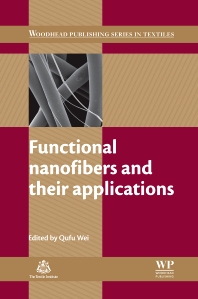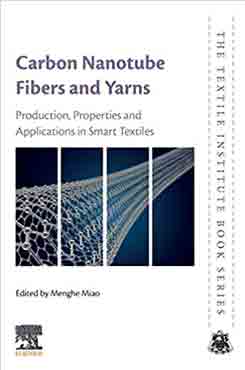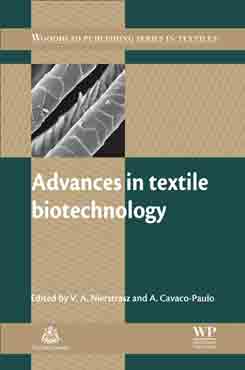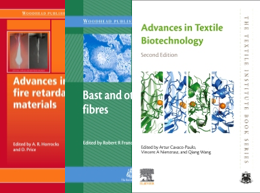Description
Nanofibers are a flexible material with a huge range of potential applications in such areas as technical textiles. Functional nanofibers and their applications summarises key trends in the processing and applications of these exciting materials.Part one focuses on the types and processing of nanofibers. Beginning with an overview of the principles and techniques involved in their production, it goes on to review core-shell, aligned, porous and gradient nanofibers.
The processing and application of composite functional nanofibers, carbon and polymer nanofiber reinforcements in polymer matrix composites, and inorganic functional nanofibers are then explored in detail, before part one concludes with a consideration of surface functionalization.
A wide variety of functional nanofiber applications are then reviewed in part two. Following consideration of their use in filtration, drug delivery and tissue engineering applications, the role of functional nanofibers in lithium-ion batteries, sensor applications, protective clothing, food processing and water purification is explored. Discussion of their use in sound absorption, electromagnetic wave attenuation and biomedical and microelectronic applications follows, before a final discussion of future trends.
With its distinguished editor and international team of expert contributors, Functional nanofibers and applications is a key text for all those working in the fields of technical textiles, as well as areas using nanofibers such as composites, biomaterials and microelectronics.
Key Features
- Summarises key trends in the processing and applications of functional nanofibres in areas such as technical textiles
- Provides an overview of the principles and techniques involved in the production of nanofibres and reviews core-shell, aligned, porous and gradient nanofibres
- Considers the use of nanofibres in filtration, drug delivery and tissue engineering applications and the role of functional nanofibres in lithium-ion batteries, sensor applications, protective clothing, food processing and water purification
Readership
Table of Contents
- Part I: Types and processingChapter 1: Nanofibers: principles and manufacture
Abstract:
1.1 Introduction
1.2 Principles of electrospinning
1.3 Solution electrospinning
1.4 Melt electrospinning
1.5 Future trends
Chapter 2: Types and processing of structured functional nanofibers: core-shell, aligned, porous and gradient nanofibers
Abstract:
2.1 Introduction
2.2 Core-shell nanofibers
2.3 Aligned nanofibers
2.4 Porous nanofibers
2.5 Gradient nanofibers
2.6 Applications of structured functional nanofibers
2.7 Future trends
Chapter 3: Processing of composite functional nanofibers
Abstract:
3.1 Introduction
3.2 Formation of polymer and polymer composite nanofibers
3.3 Formation of polymer and nanoparticle composite nanofibers
3.4 Formation of polymer and inorganic salt composite nanofibers
3.5 Examples and applications of composite functional nanofibers
3.6 Future trends
3.7 Acknowledgments
Chapter 4: Carbon and polymer nanofiber reinforcements in polymer matrix composites: processing and applications
Abstract:
4.1 Introduction
4.2 Composite formation with nanofibers
4.3 Strengths and weaknesses of nanofibers in composites
4.4 Applications of nanofiber composites
4.5 Future trends
Chapter 5: Inorganic functional nanofibers: processing and applications
Abstract:
5.1 Introduction
5.2 Processing of inorganic nanofibers
5.3 Case study: preparation, structure and properties of TiO2 inorganic nanofibers
5.4 Doping inorganic nanofibers
5.5 Applications of inorganic functional nanofibers
5.6 Future trends
Chapter 6: Surface functionalization of polymer nanofibers
Abstract:
6.1 Introduction
6.2 Surface functionalization using physical technologies
6.3 Surface functionalization using chemical technologies
6.4 Surface functionalization using nanotechnologies
6.5 Surface functionalization using biotechnology
6.6 Future trends
Part II: Applications
Chapter 7: Functional nanofibers for filtration applications
Abstract:
7.1 Introduction
7.2 Key principles of nanofibers for filtration
7.3 Filtration of nanoparticles from gas streams
7.4 Nanofiber catalyst support structures
7.5 Future trends and conclusions
7.6 Acknowledgments
7.8 Appendix: notation
Chapter 8: Functional nanofibers for drug delivery applications
Abstract:
8.1 Introduction
8.2 Drug delivery mechanisms
8.3 Applications of functional nanofibers in drug delivery: a case study
8.4 Future trends
Chapter 9: Functional nanofibers for tissue engineering applications
Abstract:
9.1 Introduction
9.2 Electrospinning of nanofibers
9.3 Applications of nanofibers in tissue engineering
9.4 Conclusions
Chapter 10: Functional nanofibers in lithium-ion batteries
Abstract:
10.1 Introduction
10.2 Components and materials in lithium-ion batteries
10.3 Applications of nanofibers in lithium-ion batteries
10.4 Examples of applications of nanofibers
10.5 Future trends
Chapter 11: Functional nanofibers in sensor applications
Abstract:
11.1 Introduction: modern electrospinning technology
11.2 Formation of nanostructured sensing materials
11.3 Sensing mechanisms
11.4 Future trends and conclusions
11.5 Acknowledgments
Chapter 12: Functional nanofibers in clothing for protection against chemical and biological hazards
Abstract:
12.1 Introduction
12.2 Chemical and biological warfare background
12.3 Electrospun nanofibers
12.4 The advantages of using electrospun nanofibers in protective clothing
12.5 Issues with development of electrospun fibers
12.6 Future trends
Chapter 13: Functional nanofibers in food processing
Abstract:
13.1 Introduction
13.2 Electrospun fibrous mats in food-related separation applications
13.3 Electrospun microfibers and nanofibers for enzyme immobilization
13.4 Electrospun nanofibers in food sensors
13.5 Electrospun micro- and nanofibers used for encapsulation and controlled release of bioactive compounds
13.6 Future trends and conclusions
13.7 Acknowledgments
13.8 Sources of further information
Chapter 14: Functional nanofibers in sound absorption, electromagnetic wave attenuation and bioreactor application
Abstract:
14.1 Introduction
14.2 Applications in sound absorption
14.3 Applications of functional nanofibers as electromagnetic wave attenuating material
14.4 Applications as a bioreactor: filtration membranes
14.5 Applications as a bioreactor: immobilization of enzymes
14.6 Future trends
Chapter 15: Functional nanofibers for water purification
Abstract:
15.1 Introduction
15.2 A new class of thin-film nanofibrous composite (TFNC) membranes
15.3 TFNC membranes for microfiltration
15.4 TFNC membranes for ultrafiltration (UF)
15.5 TFNC membranes for nanofiltration and reverse osmosis
15.6 Conclusions
15.7 Acknowledgment
Chapter 16: Functional nanofibers in microelectronics applications
Abstract:
16.1 Introduction: polymers in electronics
16.2 Electrospinning of nanofibers
16.3 Nanofibers in microelectronics
16.3.1 Nano wires
16.4 Conclusions
16.5 Acknowledgments
Chapter 17: Future trends in the processing of functional nanofibers
Abstract:
Index
